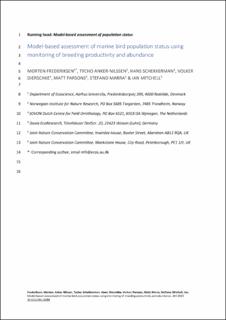| dc.contributor.author | Frederiksen, Morten | |
| dc.contributor.author | Anker-Nilssen, Tycho | |
| dc.contributor.author | Schekkerman, Hans | |
| dc.contributor.author | Dierschke, Volker | |
| dc.contributor.author | Parsons, Matt | |
| dc.contributor.author | Marra, Stefano | |
| dc.contributor.author | Mitchell, Ian | |
| dc.coverage.spatial | Greater North Sea region, Northwest Europe | en_US |
| dc.date.accessioned | 2023-12-15T09:22:56Z | |
| dc.date.available | 2023-12-15T09:22:56Z | |
| dc.date.created | 2023-12-12T19:52:19Z | |
| dc.date.issued | 2023 | |
| dc.identifier.citation | IBIS. 2023, . | en_US |
| dc.identifier.issn | 0019-1019 | |
| dc.identifier.uri | https://hdl.handle.net/11250/3107698 | |
| dc.description.abstract | Vertebrate populations are often monitored as part of broader assessments of ecosystem status, where they are expected to provide information on the ability of the ecosystem to support higher-level predators. However, because many vertebrates are long-lived and often only subsets of their populations can be monitored, abundance may not be sufficiently responsive to ecosystem status to provide early warnings of impending changes. Marine birds are often used as indicators of ecosystem status but, due to their long lifespan and delayed recruitment to the breeding population, changes in abundance are generally slow and often difficult to interpret. Their breeding productivity is, however, also widely monitored and much more responsive to ecosystem status, but the relevance of variation in productivity may be difficult to assess. We propose a model-based indicator that integrates monitoring of abundance and breeding productivity through demographic matrix models. The metric of the proposed indicator is the expected population growth rate, given the observed level of breeding productivity. This expected growth rate is then compared with a threshold derived from the criteria employed for red-listing of threatened species by the International Union for the Conservation of Nature. We demonstrate the suggested approach using data from Black-legged Kittiwakes Rissa tridactyla in the Greater North Sea region, Northwest Europe. The proposed indicator shows that the current level of breeding productivity is expected to lead to a population decline of 3–4% per year, which is equivalent to a red-list status as Endangered for the species in this region. Our indicator approach is used in OSPAR’s Quality Status Report 2023 and is expected to be used by European Union member states for reporting under the Marine Strategy Framework Directive in 2024. Our approach represents a major step forward in assessing the status of marine bird populations; the ideal next step would be to develop a coherent Integrated Population Modelling (IPM) framework that would allow inclusion of all data on population abundance and demography collected across the large and diverse marine ecosystems involved. breeding success, indicator, Marine Strategy Framework Directive, seabirds. | en_US |
| dc.language.iso | eng | en_US |
| dc.rights | Navngivelse 4.0 Internasjonal | * |
| dc.rights.uri | http://creativecommons.org/licenses/by/4.0/deed.no | * |
| dc.subject | breeding success | en_US |
| dc.subject | indicator | en_US |
| dc.subject | Marine Strategy Framework Directive | en_US |
| dc.subject | seabirds | en_US |
| dc.title | Model-based assessment of marine bird population status using monitoring of breeding productivity and abundance | en_US |
| dc.title.alternative | Model-based assessment of marine bird population status using monitoring of breeding productivity and abundance | en_US |
| dc.type | Peer reviewed | en_US |
| dc.type | Journal article | en_US |
| dc.description.version | acceptedVersion | en_US |
| dc.rights.holder | © 2023 The Authors | en_US |
| dc.subject.nsi | VDP::Zoologiske og botaniske fag: 480 | en_US |
| dc.subject.nsi | VDP::Zoology and botany: 480 | en_US |
| dc.source.pagenumber | 11 | en_US |
| dc.source.journal | IBIS | en_US |
| dc.identifier.doi | 10.1111/ibi.13288 | |
| dc.identifier.cristin | 2212643 | |
| dc.relation.project | EU/...... | en_US |
| cristin.ispublished | true | |
| cristin.fulltext | postprint | |
| cristin.qualitycode | 1 | |

